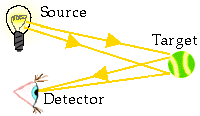fundamental? The modern atom model The scale of the atom What are we looking for? The standard model The standard model quiz
|
Detecting the world Let's look at the most familiar example of this source/target/detection scheme: the way in which we perceive the world. What we think of as "light" is really made up of billions and trillions of particles called "photons." Photons, like all particles, also have wave characteristics. For this reason, a photon carries information about the physical world because it interacts with what it hit.
Our brain analyzes the information, and creates the sense of a "tennis ball" in our mind. Our mental model of the tennis ball helps to describe the reality around us. We use the information of bounced-around light waves to perceive our world. Other animals, like dolphins and bats, emit and detect sound waves. In fact, any kind of reflected wave can be used to get information about the surroundings. |






















 For example, imagine that there is a light
bulb behind you, and a tennis ball in front of you.
Photons travel from the light bulb (source),
bounce off the tennis ball (target), and
when these photons hit your eye (detector),
you infer from the direction the photons
came from that there is a round object in front of you.
Moreover, you can tell by the different photon
wavelengths that the object is green and tan.
For example, imagine that there is a light
bulb behind you, and a tennis ball in front of you.
Photons travel from the light bulb (source),
bounce off the tennis ball (target), and
when these photons hit your eye (detector),
you infer from the direction the photons
came from that there is a round object in front of you.
Moreover, you can tell by the different photon
wavelengths that the object is green and tan.